On introducing your company
Prelude
Min Guhong is the owner of Min Guhong Manufacturing, a parasitic and one-man company based in Seoul. The company has made products in its spare time since 2015. In addition to interests including industry, business, economy, and poetry, the company likes exploring the world wide web because it’s easy to publish and easy to access. And most importantly, the web is the last thing many people see before they fall asleep.
Conversation
On introducing your company
CEO and editor Min Guhong on how a company can be a therapeutic tool for living, the complex appeal of products, the guiding quality of names, and embracing conventions to explore modern life.
As told to Laurel Schwulst, 3144 words.
Tags: Writing, Technology, Poetry, Business, Identity.
Tell me about your company.
My company, Min Guhong Manufacturing (sometimes abbreviated Min Guhong Mfg.), is a one-man parasitic company. By parasitic, I mean it feeds on other companies. This is how it survives.
Currently Min Guhong Mfg. feeds on “Workroom,” a Korean graphic design studio and publishing house. Before Workroom, my company fed on “Ahn Graphics,” another Korean graphic design firm. (These are both places I work or worked.)
When I first started my company in 2015, even though I didn’t know entirely what it was yet, I attempted to introduce it to the world. So I made a long list of facts titled About the Company…

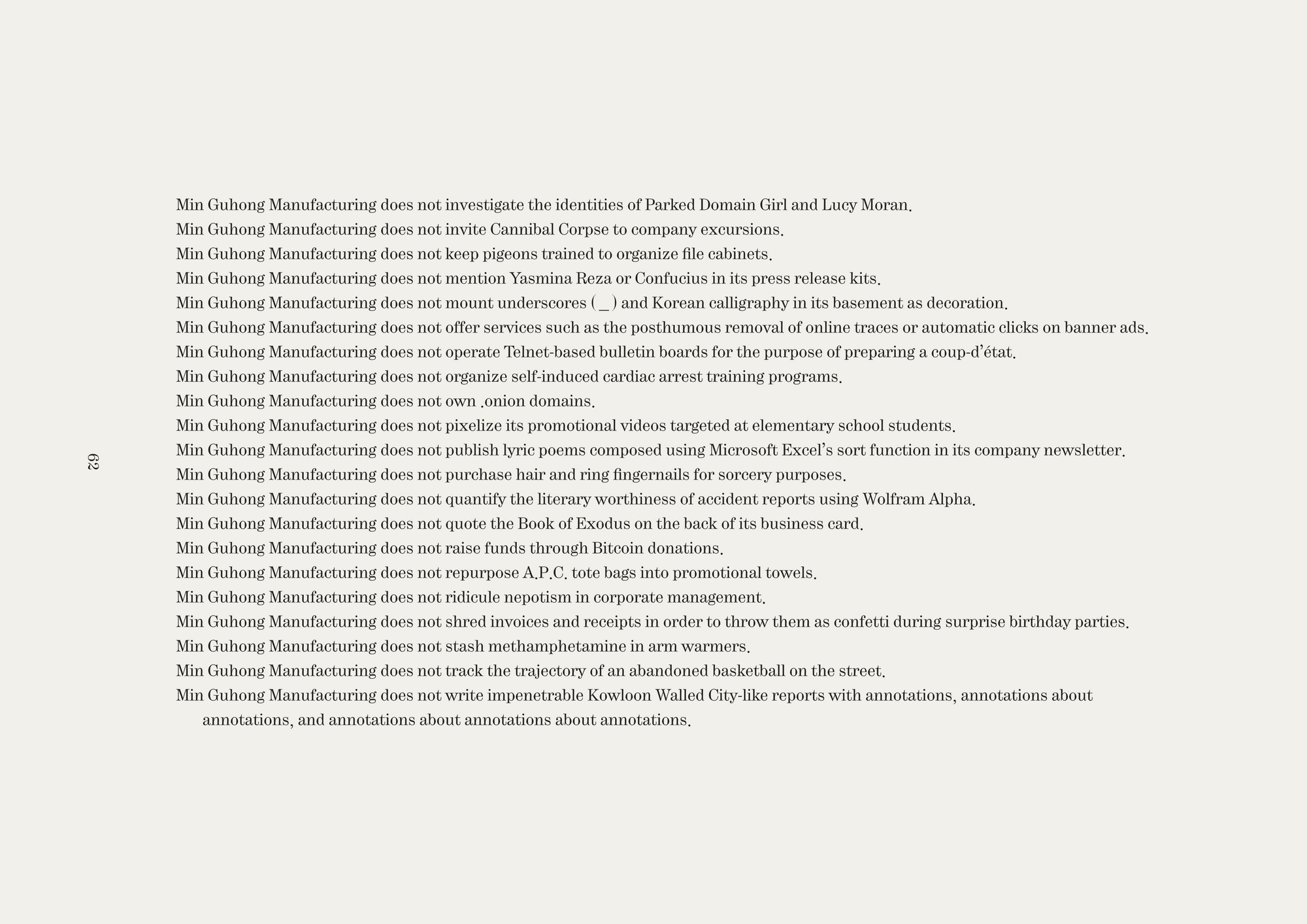
About the Company, 2015. Writing. Translated by Koh Achim, designed by Hong Eunjoo and Kim Hyungjae.
I created this list at the very beginning, when the company’s practice was uncertain, as it still is to some extent. You can see by reading this list that I believe that what a company doesn’t do is more important than what it actually does. Each item on the list, including “Min Guhong Mfg. does not raise funds through Bitcoin donations,” is still true and in effect.
A few months ago, while I was visiting New York, I decided to add some items to the list. I also needed to revise some existing items. Although I didn’t formally add it to About the Company, I made a decision about the company’s main practice—or at least one of its main practices—and turned it into a sentence:
“Min Guhong Manufacturing focuses, more than anything, on presenting itself.”
Then I thought it would be nice to add a phrase:
“Min Guhong Manufacturing focuses, more than anything, on presenting itself in various forms.”
Wow. So I understand that after time passed, you were able to define your company positively (by what it *does*). But in the beginning, you only defined your company negatively (by what it *does not* do). Why did you do this?
About the Company looks like a manifesto. However, it did not come from strict principles.
At the time, it was the best thing I could come up with for a company I founded but did not yet know what it was. What’s most important here is the manifesto quality itself: the company defining itself, rather than the specifics of what the company does not do. In order to allow more possibilities for future maneuvering, I thought it best to define what *not to do* instead of the opposite.
Tell me about your company’s name.
The first part of the company’s name is my name, “Min Guhong.”
The second word is “manufacturing,” which typically refers to the industrial mass-production of products in which raw materials are processed through human labor, machines, or other methods. In Korean, the word “manufacturing” also means something specific within the sport of baseball—scoring runs through means other than base hits, such as stealing or sacrifice bunts. I believe naming is extremely important. As a guiding force, I wanted my company’s name to reflect both the functionality and opportunity embedded in this word, “manufacturing.”
You might not be able to tell from this interview, but I am actually a very shy and sensitive person. That is, I am easily pleased or upset by others’ opinions towards me. This used to be a burden. But by standing behind the facade of my company, I am able to separate my life from my work and become somewhat indifferent to what other people say. This is similar to how the performance artist Andy Kaufman created and performed the character Tony Clifton, who reflected Kaufman’s other self. My company, Min Guhong Mfg., is my Tony.
What’s the working style of your company like?
I work eight hours, from 10am–7pm on weekdays as an editor at Workroom. During these fixed work hours, I happily and diligently fulfill my duties as an employee. I usually squeeze in a couple hours after work for Min Guhong Mfg. projects. (This is why Min Guhong Mfg. products seem to be, and sometimes actually are, simple and carefree in feeling.) Although I must admit that the boundaries sometimes become blurred.
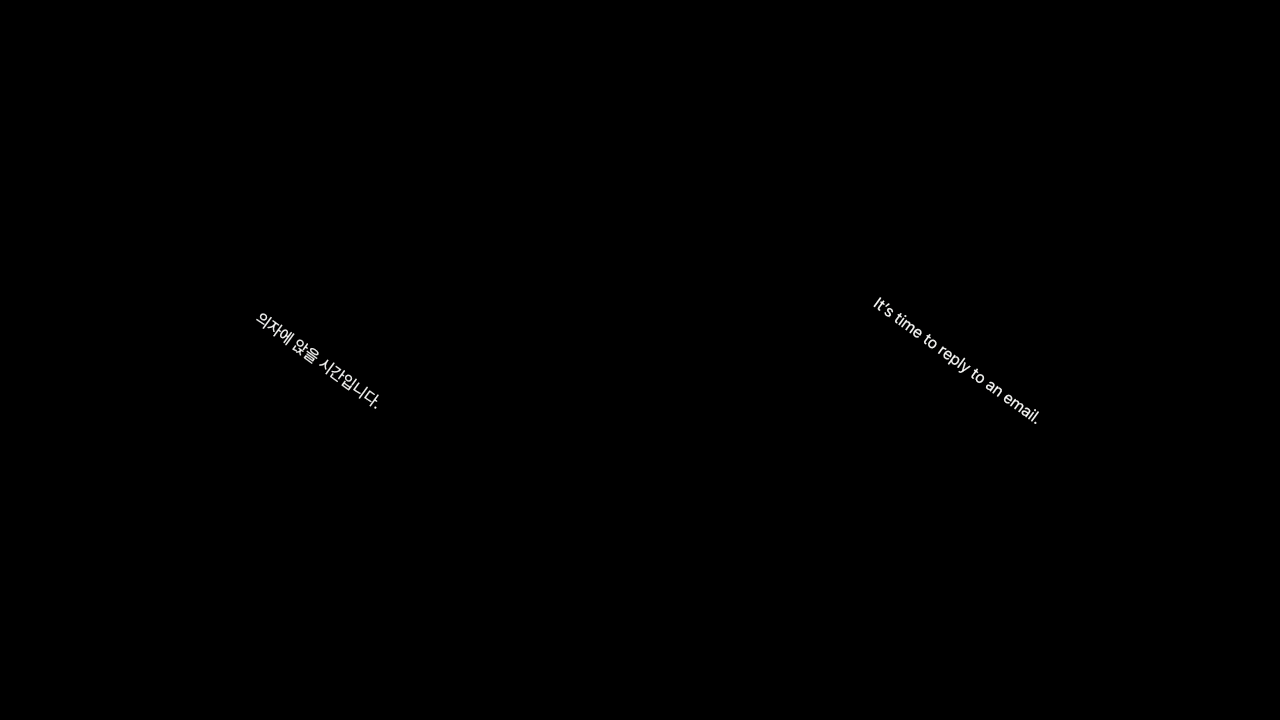
Fixed Work Hours, 2019. Website, clock. http://products.minguhongmfg.com/fixed-work-hours
How does it feel to be parasitic? Is this a modern, therapeutic way of working?
Min Guhong Mfg. is parasitic and lives off of the workspace of its employer instead of existing independently because of my lack of capital and courage. In addition, I am uninformed when it comes to taxes. I’m also unable to work efficiently at home alone.
As a result, Min Guhong Mfg. offers labor and some level of entertainment in exchange for operational costs and access to its host’s real estate and possessions—such as working space, computers, desks, Wi-Fi, and coffee. This setting enables a platform in which my company can run as a hobby, or for the sake of personal happiness without the need to generate profit.
My wish is for my company and its host to provide each other’s necessities, similar to how someone once told me that you can grow together by “exploiting each other.” So this is different from parasitism in its common definition, in which the parasite lives on or inside of another organism, the host, causing it some harm. The benefit only goes one way. But in my case, I think it’s not so unidirectional. Min Guhong Mfg. also has multiple sources of nutrition—my host as well as the customers’ love and interest.
Describe your ideal lifestyle.
In short, waking up at an appropriate time, eating at an appropriate time, exercising at an appropriate time, and sleeping at an appropriate time. Most importantly, spending an appropriate amount of energy in securing said appropriateness. Compensating lack of sleep with coffee, energy drinks, or clumsy self-hypnosis is acceptable at most a couple times a month.
How do you define a product? Why does your company focus on products?
Min Guhong Mfg.’s products are actually more like by-products created while presenting or introducing the company.
I use the word “product” mainly because Min Guhong Mfg. is a company. If Min Guhong Mfg. was an artist or similar individual, it might be more natural to use “piece” or “work.” To me, the word “product” is refreshing in that it is generic and neutral; it is also grim in that it implies the characteristics, mostly negative, of the market economy in which we exist. Maybe I created the company as a means of approaching the complex appeal of “product,” and not the other way around.
The distinction between company introductions and products is simply for convenience; the categories are more like hashtags. Some things are closer to company introductions, while others are both company introductions and products.

Since many of your products are digital, you must ponder the purpose of technological advancement. Can such such products truly improve our lives?
In a visit to the electronics-filled Akihabara district of Tokyo in the winter of 2009, the American documentary filmmaker Michael Moore said, dumbfounded, “A lot of unnecessary things are being sold here. Shopping may brighten the spirits, but they’re just fooling themselves.”
Will the technology company Dyson’s latest wireless vacuum cleaner, faster and more efficient than any model before it, make us happier? Is a world where we can download a petabyte in one second a more beautiful world than one in which we could only download a gigabyte? Technological advances may have nothing to do with maintaining our happiness. Even though I admit such advances allow you and me to connect more conveniently.
In any case, as someone who administers a company, I do have a sense of responsibility when it comes to putting out products into the world. This is why Min Guhong Mfg. does not manufacture chemical and biological weapons, surveillance equipment, or shower curtains, as it says in About the Company.
What’s the relationship between products and your work as an editor?
Actually, editing (or rather the word “edit”) is everywhere nowadays. Speaking of (digital) products, I’m reminded of iPhone’s default Mail app:
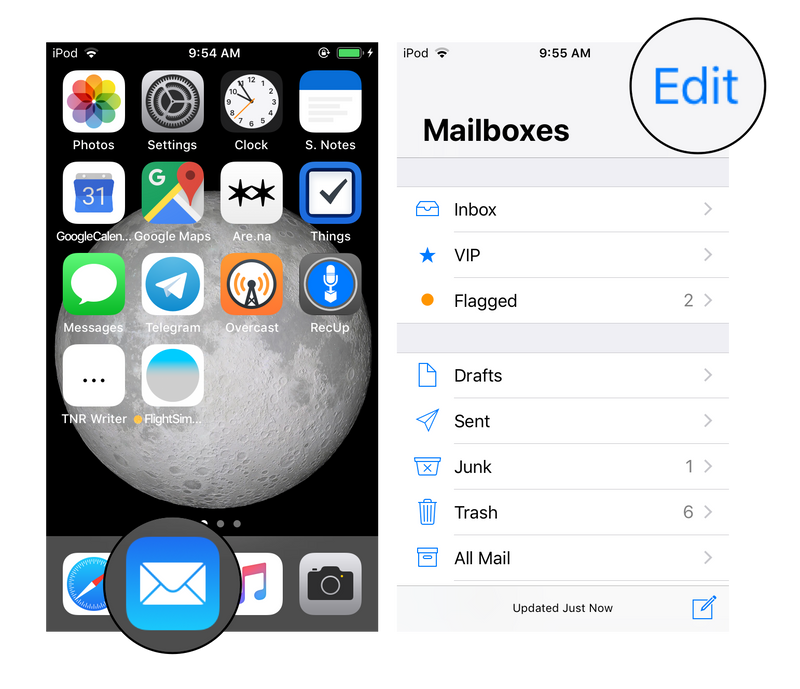
I studied creative writing and linguistics while at university. In a fiction writing class, my professor told us that his motivation for writing fiction was that he “just wanted to be good at lying.” He added that “in order to do so, one needs to let facts coexist with fiction.” Looking back, I seem to have been a rather good student.
Recently I ambitiously decided to render the information for each of my company’s products into citation format. (The preliminary title for this project is Press Release Standard Format.) So I am studying the citation format of the Chicago Manual of Style as a reference. The format is quite beautiful in that it is functional and strikes a pure balance of content and form. An example of a product displayed with Min Guhong Mfg.’s press release format might look like this:
Name of Product, “Quote,” Type of Product (separated by a middle dot [·] when more than one), Collaborators (separated by a middle dot [·] when more than one), Year of manufacturing and/or release.
My use of conventions is due to a lack of talent in terms of creating formative beauty from scratch. As much as education has been democratized through the web, some things are just unfeasible. This is also why I enjoy spending time with friends who are designers, as they can show me their favorite conventions and systems.
The keychain is one convention my company explored recently. Typically, one puts keys on a keychain. This is the keychain’s intended use. But what happens when you print the sentence “Min Guhong Manufacturing” can be abbreviated as “Min Guhong Mfg.” in sans-serif on it, or wear the keychain as a ring? And what happens when a company advertises this keychain as a product with the title “Min Guhong Manufacturing Guidelines (English)?” It is much more than a keychain now.
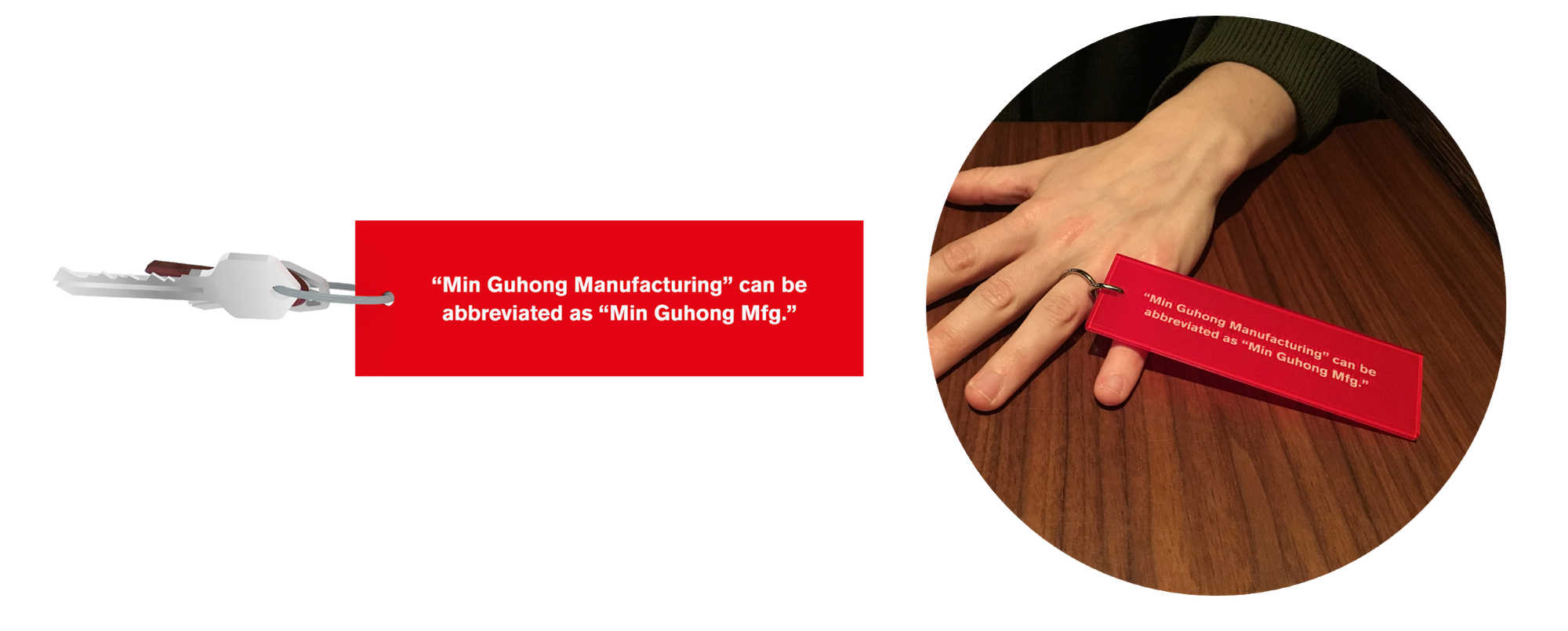
Min Guhong Manufacturing Guidelines (English), 2017. Writing, keychain, ring.
Min Guhong Mfg. is also interested in the limits of typography’s conventions. You know, it takes quite some effort to make things seem like they do nothing. Times Blank is a typeface based on Times New Roman but with every character deleted. Times Blank is Min Guhong Mfg.’s official typeface. It goes well with John Cage’s 4’ 33” as background music. You can test it out on this website.
Is it true your company had an exhibition in 2018? Was it strange for a company to have an exhibition, when they typically do trade shows or keynotes?
Actually, it was a great opportunity to present my company. As long as I get to introduce my company, I don’t mind Min Guhong Mfg. being summoned in a white cube. The company’s products were shown without a clear structure; in that sense, I think the title of the exhibition—”Rainbow Sherbet”—was appropriate.
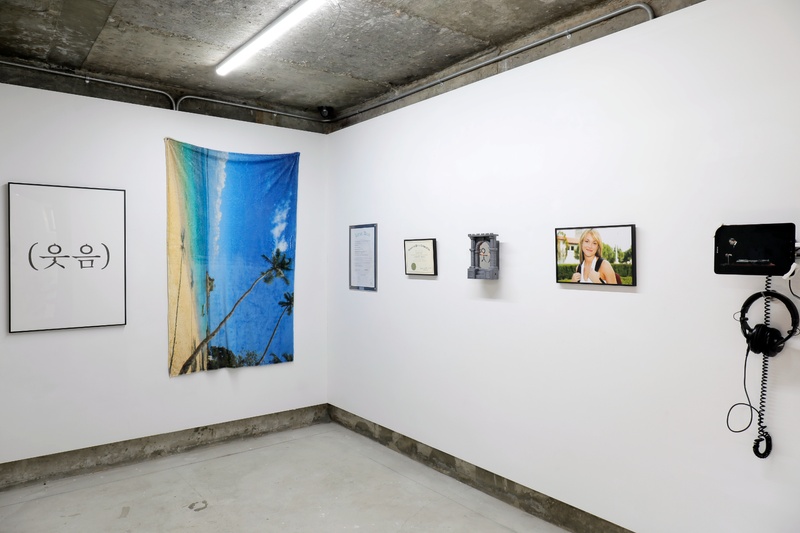
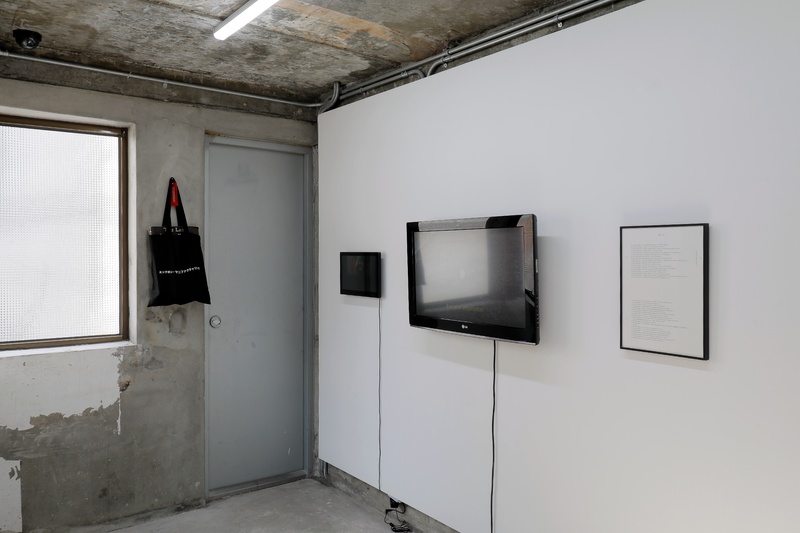
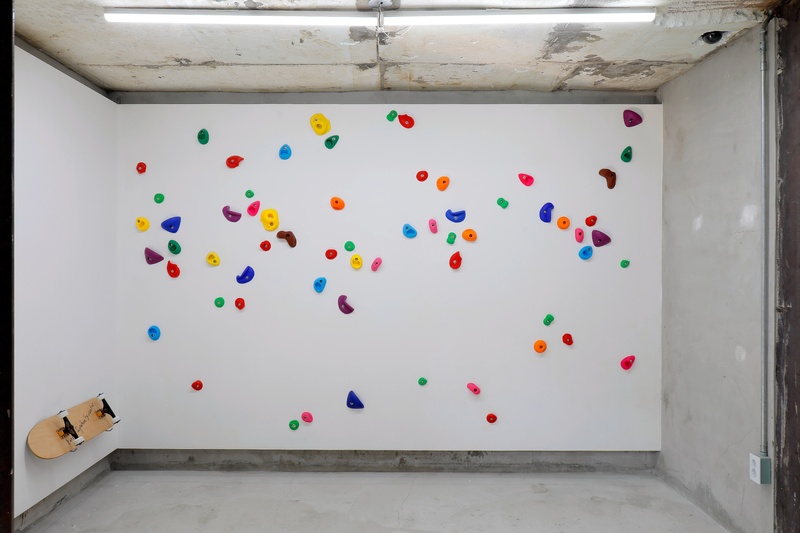
Installation images from Rainbow Sherbet (Seoul: Archive Bomm, 2018). Photo by Nathing Studio.
Some products exhibited were the result of collaboration, which is an important manufacturing method for the company. Partnership allows for better products. Not only is it difficult to do everything well by oneself, but more importantly, it is unhealthy. During the collaborations, Min Guhong Mfg. operated much more like a company. Partners were selected through meetings; orders were sent; in turn, the partners delivered products that they manufactured.
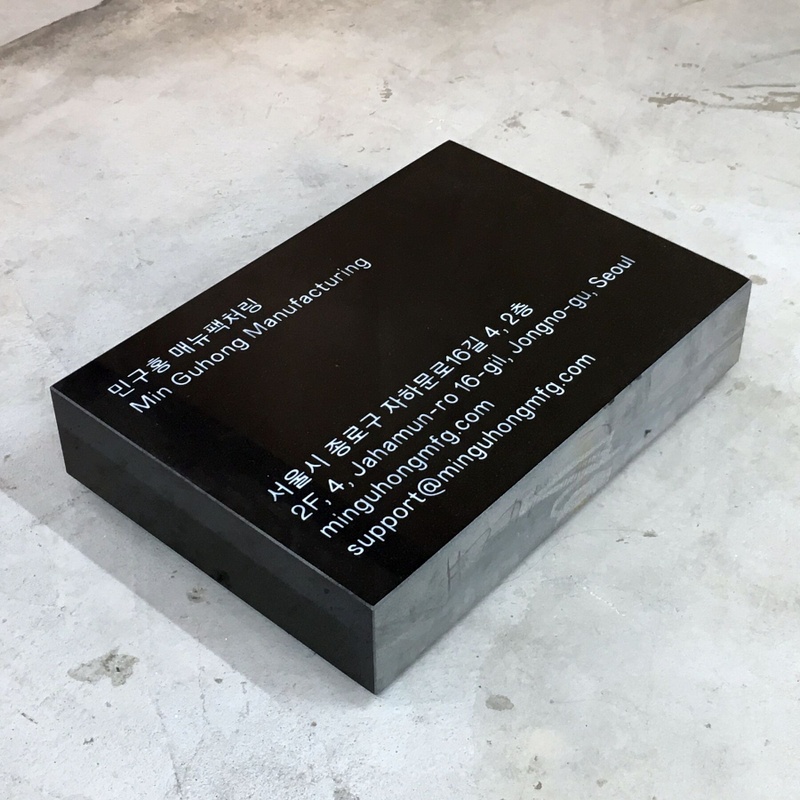
Min Guhong Manufacturing Business Card, 2018. Business card. In collaboration with Moonsick Gang. Photo by Nathing Studio.
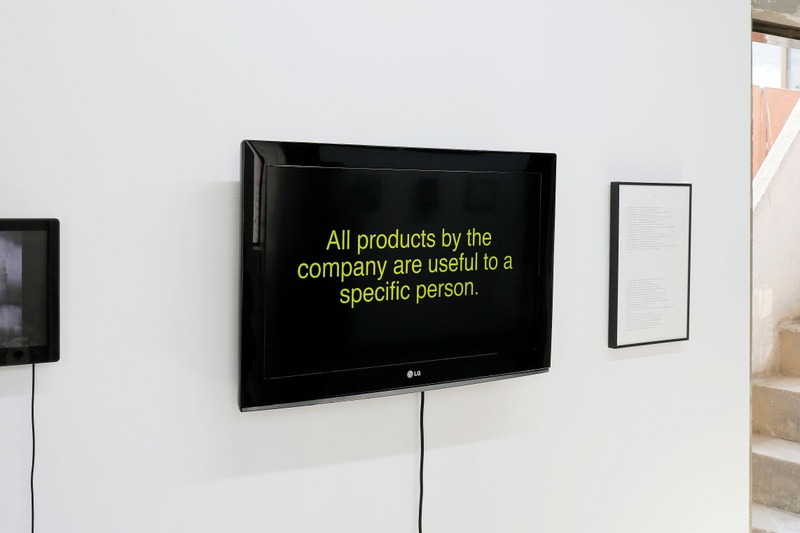
Installation still of For Your Information, 2018. Single-channel video, 4 minutes 14 seconds. In collaboration with Laurel Schwulst. Photo by Nathing Studio.
As a result, Min Guhong Mfg. now has a business card, an introductory video (which you can watch online), and a short story by Nuiyeon Kim introducing the company (which is available in Korean on our website)…
Another outcome of the exhibition was that this character “Fuchsine” came out of the computer and into the real world…

Fuchsine, 2017. Mascot. Photo by Nathing Studio. http://products.minguhongmfg.com/fuchsine
You can recognize Fuchsine by its rounded square magenta body with three dots in its center. It also has been used as the official mascot of Min Guhong Mfg.
Fuchsine was actually born a long, long time ago inside a website the company made. Whenever a user clicked on it, it spouted some monologue. It is definitely a character in every sense of the word; it enjoys special noodles (Pyongyang-style naengmyeon), and while it dreams of one day rocking a pair of Balenciaga’s Triple S sneakers, unfortunately it doesn’t have legs or feet yet.
The exhibition’s opening also featured general-purpose DJing, in collaboration with Maalib.
Since you work with text, your company’s output is often presented in the Korean language. What do you make of the Korean language?
It is a pure coincidence that I was born into a Korean family. The same goes with Hangul, the Korean written language. Hangul being an “advanced character system,” as it is often described as, does not really interest me. It is not easy to talk about coincidences.
The reason I like Korean is simply because it is a tool that I can use very well, like web markup and programming languages HTML, CSS, and JavaScript.
A few years ago, Min Guhong Mfg. participated in building the Google Fonts + Korean website. Hangul consists of 19 consonants and 21 vowels. Combinations of consonants and a vowel constitute a character, so there are 17,388 possible combinations. This characteristic affects not only the making of Korean typefaces, but especially their usage on the web.
As an example, on Google Fonts, the roman-alphabet “Noto Sans” font file is 455 KB; the Korean version of the same font is more than four times its size, weighing in at 2.2 MB. It may be a small difference, but in the split-seconds during which the browser is finishing downloading the font files, the page will flicker and/or not be displayed correctly. Google attempted to apply machine learning to minimize this phenomenon.
I sometimes wonder which will be first achieved by Google, the complete eradication of such flickering or the democratization of language through an improved translation technology.
Do you translate much?
I don’t consider myself a translator, but based on my experience, translation is a similar process to coding. There is a starting language (input), a destination language (output), and the translation (function) between the two.
Interestingly enough, this was also similar to another process I have learned, writing poetry: poetic object (input), poetry (output), and the poetic perception (function) in-between. This thought became clearer when I thought about my experience at The School for Poetic Computation, where I was a student during the Summer 2016 session. This is why I like to say that I learned literature and linguistics there, instead of computer programming.

Welcome to Min Guhong Manufacturing ROM cartridge, 2019. Photo by BEM.
Describe the qualities of your favorite book. Is it similar to your favorite website?
At first sight, it seems peaceful and innocent, but upon further examination it reveals its indecent self. Or vice-versa. It maintains its initial logic and principles until its end, while at the same time destroying them. It is light.
As a consumer, I am not too picky about content; as long as it is useful to me, it is good enough. This can be relative and fluid. Timing also matters. However great a book is, it only matters if I actually need that book at that moment in my life.
As for the form of a book, I have more things to say. I like micro-typography as perfect as it can be; but I am much more relaxed about macro-typography. Sometimes all you need is a nice picture of a flower on the front cover. What’s more important is whether that flower is a daffodil or a poppy.
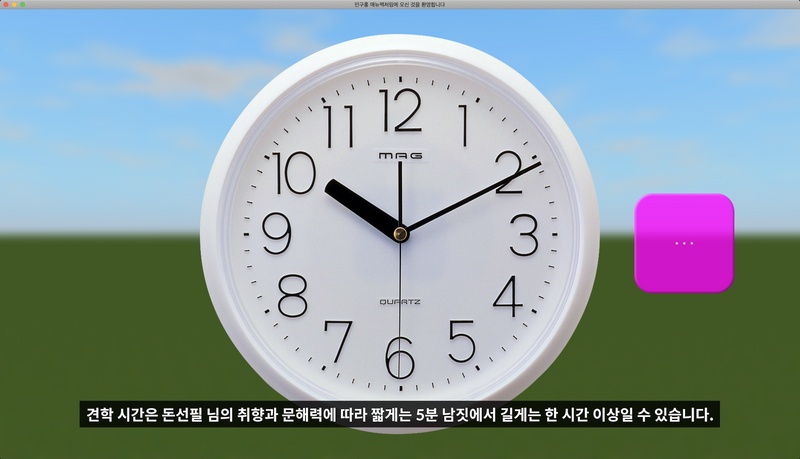



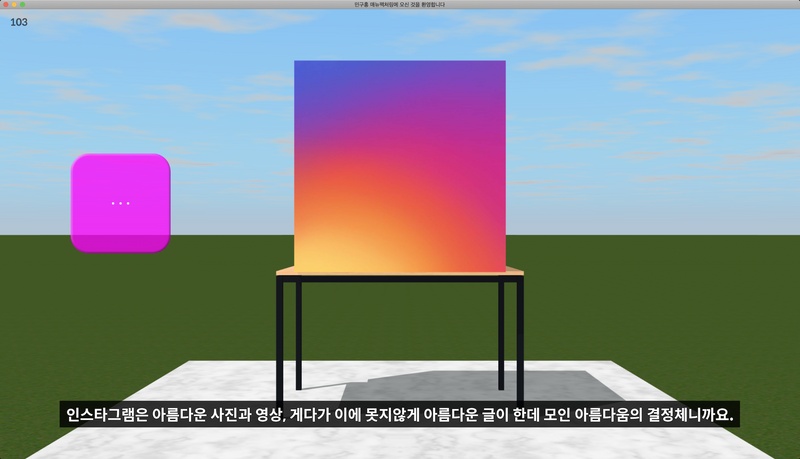

Welcome to Min Guhong Manufacturing, 2019. Visual novel. https://minguhongmfg.itch.io/welcome
As far as websites go, I teach interactive design at a design school. I tell students that websites are books without size, volume, or weight; and that books are websites without hyperlinks and scrollbars, but with volume and weight. As you know, the web started as a means for scientists to collaborate by sharing papers; so the form of the website borrows heavily from that of the book. At some point, the two went separate ways, but both are headed towards the same destination. (I believe the two forms’ trajectories exist in a tesseract.)
Of course, books are inconvenient when you have to move. On the other hand, a website can be edited anytime, even after “publishing” it; if you don’t exercise restraint and determination, you risk suffering from carpal tunnel syndrome.

Two T-shirts, 2019. T-shirts. In collaboration with BEM.
What’s the most rewarding project/product you’ve worked on?
Min Guhong Mfg. itself. Because it is a tool that makes a person’s life—mine—into a well-rounded operation. The company is the reason I can sit with you and talk about these things; without Min Guhong Mfg., I wouldn’t have dared say out loud that I lack capital and courage. Instead, I would have pretended to be happy and roamed around the U.S. or the Netherlands.
Does Min Guhong Mfg. have any role model companies?
Of course it does. But that’s a (trade) secret. Not that there is anything too special about them. As we know, secrets nowadays are truly secrets only outside the internet; outside the servers of Google or the Internet Archive’s Wayback Machine…
Top five favorite fruits (in order of decreasing size, with calories per 100 grams):
-
Watermelon, 30 kcal
-
Melon, 34 kcal
-
Peach, 39 kcal
-
Fig, 74 kcal
-
Cherry, 63 kcal
- Name
- Min Guhong
- Vocation
- CEO, Editor
Some Things
Pagination



